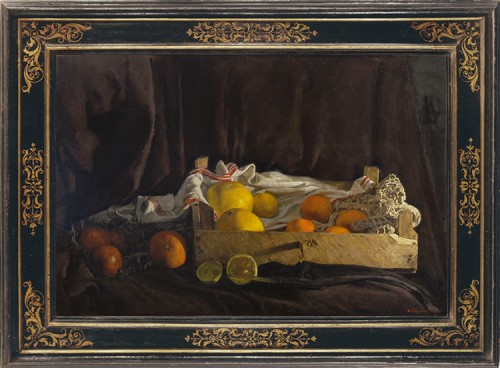Citrus fruits were grown in southern Europe from the Middle Ages, quickly becoming popular subjects for artists. They were markers of wealth and status; emblematic (associated with the fruit of the Hesperides in Classical myth, and with the ‘apple’ of Eden in the Bible); medicinal, and thus also linked symbolically with funerals and resurrection. Striking still life paintings of citrus fruits were executed in Italy, Spain and Holland, perhaps especially during the 17th century. Weissbort’s painting is an homage to these pictures – to the work of Luis Melendez, whose paintings include not only oranges and lemons, but the round wooden boxes in which food was packed (Still life with citrus fruit, York Gallery). In Weissbort’s picture, as in Melendez’s, the wooden crate is an important element, hinting at the exotic origins of the fruit, and undercutting the different treatment they often receive in Dutch still life paintings – arranged in priceless porcelain bowls or scattered amongst silver and golden goblets. Weissbort’s crate gives texure to the work; it harmonizes with the sunny tones of the fruit, and in its throwaway nature provides an ironic contrast with the brown drapery of the background. This is a beautifully composed, sensuous still life, looking back overtly to paintings by Gerrit van Honthorst and Giuseppe Ruoppolo.
Biographical details
George Weissbort (1928-2013) was born in Belgium and moved to London at the age of 7. He attended the Central School of Art & Design (now St Martin’s) where he was taught by Ruskin Spear and Rodrigo Moynihan. He was influenced by Arthur Segal to move from the abstract expressionism of the 1940s to realism, and by Bernard Meninsky, who taught life drawing at the Central School, to study the Old Masters. He turned first to artists such as Cézanne and Matisse, and later to Vermeer, Chardin, Velasquez, Corot, Titian, Holbein, and Piero della Francesca, amongst others.
He exhibited regularly at the Royal Academy, the Royal Society of Portrait Painters and the Fine Art Society. In 1964-65 he had a large exhibition in Paris, and in 2006 he had a one-man retrospective at the Chambers Gallery, London, followed in 2008 by another at the Denise Yapp Gallery, Whitebrook, Monmouth.
He wrote essays on art and criticism which look both at the techniques of making a painting, and of appreciating a work of art. The latter skill he believed came only after years of consciously training the eye to see as the artist saw, considering for example the ‘negative’ spaces around and between objects. He also discussed the work of specific artists, such as Lucien Freud and Vermeer.
His obituary in The Independent quotes Brian Sewell, a friend, as saying of him that Weissbort ‘painted the right pictures at the wrong time’. His appeal was to those who understood his models and influences; he could be described as a painter’s painter, and the same obituary quotes Paula Rego describing him as ‘a truly honest artist who knows so much about painting’.
Publications: George Weissbort, Paintings and Drawings (Parnassus, 2008), ill. 130 colour plates; includes transcripts of a filmed interview; essays by Tony Rudolph, David Lee and Bernard Dunstan RA.
YouTube video: A tribute to George Weissbort by John French.


